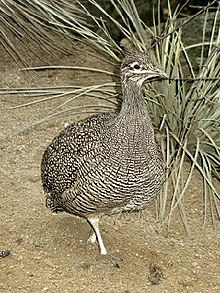Crypturus
| Tinamou Temporal range: Miocene – Recent 10–0 Ma |
|
|---|---|
 |
|
| Elegant crested tinamou (Eudromia elegans) | |
| Scientific classification | |
| Kingdom: | Animalia |
| Phylum: | Chordata |
| Class: | Aves |
| Clade: | Notopalaeognathae |
| Order: |
Tinamiformes Huxley, 1872 |
| Family: |
Tinamidae G. R. Gray, 1840 |
| Type species | |
|
Tinamus major Gmelin, 1789 |
|
| Genera | |
|
|
| Diversity | |
| 2 subfamilies, 9 genera, 47 species, 127 subspecies | |
 |
|
| Range of the family | |
| Synonyms | |
|
|
Tinamous, inambusyutos form an order (Tinamiformes), comprising a single family (Tinamidae) with two distinct subfamilies, containing 47 species of birds found in Mexico, Central America, and South America. The word "tinamou" comes from the Galibi term for these birds, tinamu. One of the most ancient living groups of bird, they first appear in the fossil record in the Miocene epoch. Tinamous have traditionally been regarded as the sister group of the flightless ratites, but recent work places them well within the ratite radiation, implying basal ratites could fly. They are generally sedentary, ground-dwelling and, though not flightless, when possible avoid flight in favour of hiding or running away from danger. They are found in a variety of habitats, ranging from semi-arid alpine grasslands to tropical rainforests. The two subfamilies are broadly divided by habitat, with the Nothurinae referred to as steppe or open country tinamous, and the Tinaminae known as forest tinamous.
Although some species are quite common, tinamous are shy and secretive birds. They are active during the day, retiring to roosts at night. They generally have cryptic plumage, with males and females similar in appearance, though the females are usually larger. They are opportunistic and omnivorous feeders, consuming a wide variety of plant and animal food from fruits and seeds to worms, insects and small vertebrates. They will dust-bathe as well as wash themselves by standing in heavy rain. They are heard more often than seen, communicating with each other by a variety of frequently given, characteristic calls, especially during the breeding season.
...
Wikipedia
